Information System Implementation Proposal for Jetstar Airways
VerifiedAdded on 2023/04/23
|23
|5338
|441
Report
AI Summary
This report proposes the implementation of an information system at Jetstar Airways to address operational challenges and improve overall business performance. It begins with an overview of Jetstar Airways, including its marketing and external environment analysis using Porter's Five Forces, followed by an internal SWOT analysis. The report identifies the problem of flight delays due to the lack of an effective information system and suggests adopting an Operations Information System. A cost/benefit analysis justifies the investment, and the report outlines the System Development Life Cycle (SDLC), including planning, defining, designing, building, testing, deployment, and maintenance phases. Post-implementation activities such as employee training and expert hiring are discussed, along with project management, change management, and risk management strategies associated with the system implementation. The report concludes by emphasizing the potential benefits of the information system in enhancing Jetstar Airways' operational efficiency and customer satisfaction.
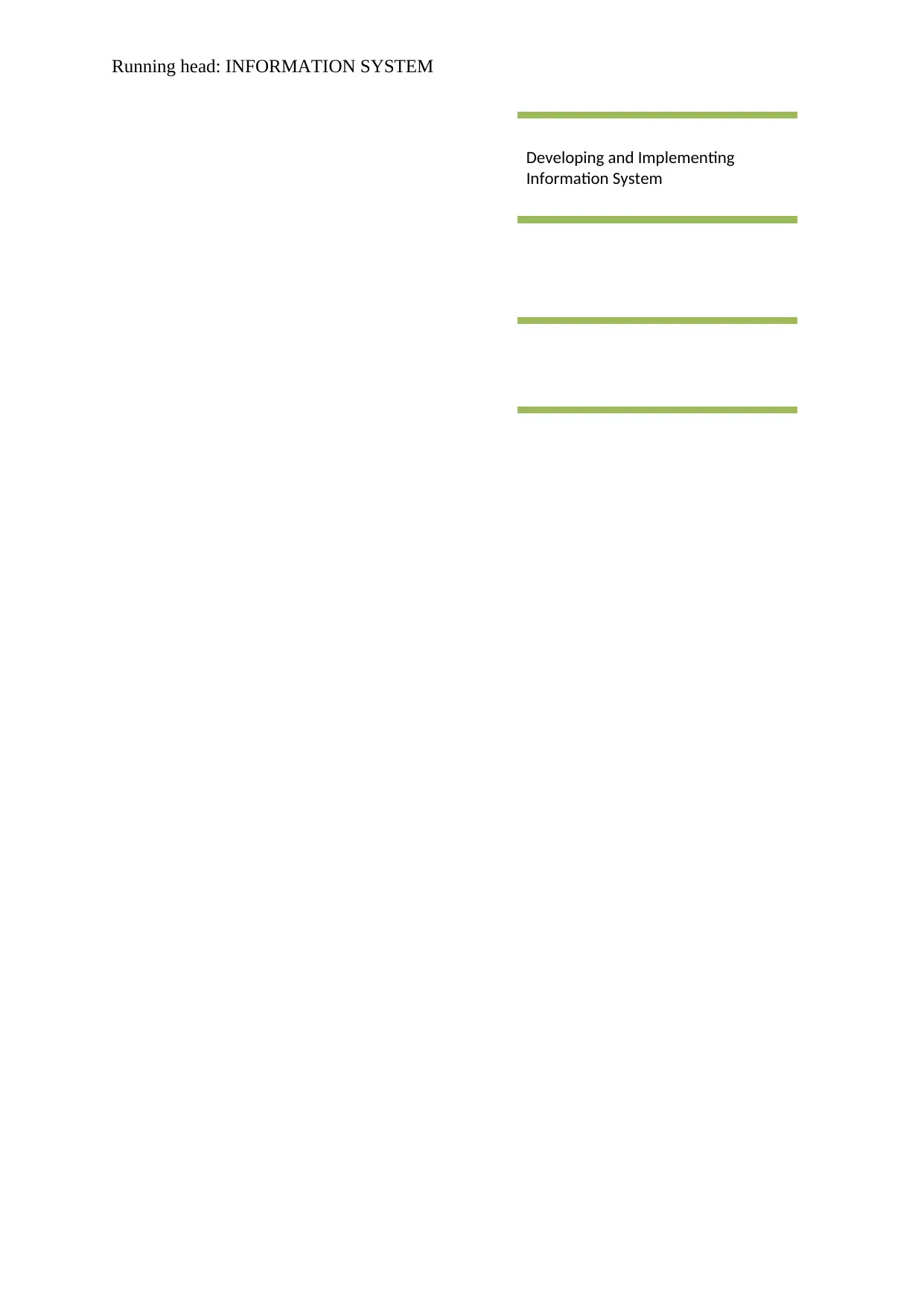
Running head: INFORMATION SYSTEM
Developing and Implementing
Information System
Developing and Implementing
Information System
Paraphrase This Document
Need a fresh take? Get an instant paraphrase of this document with our AI Paraphraser
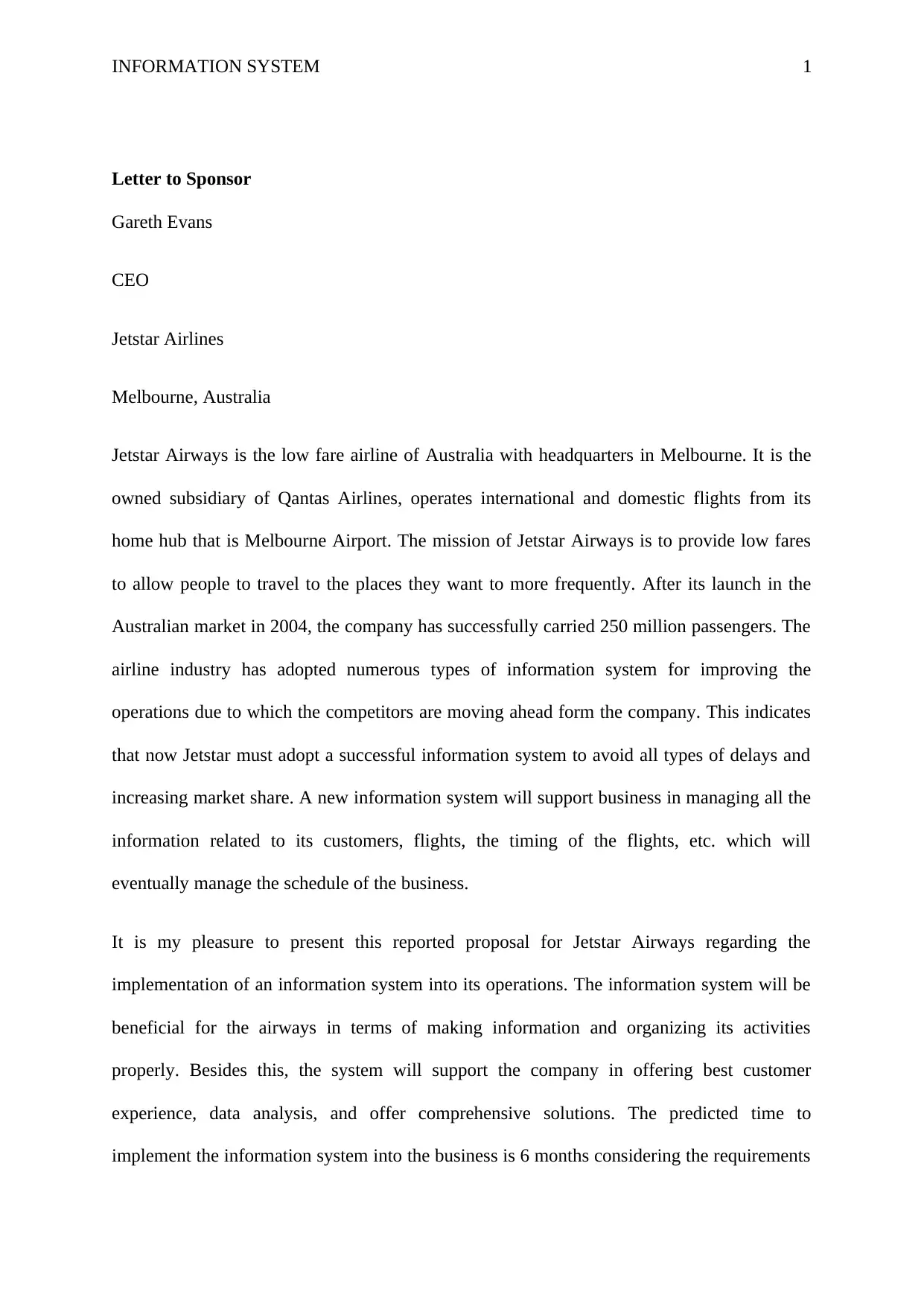
INFORMATION SYSTEM 1
Letter to Sponsor
Gareth Evans
CEO
Jetstar Airlines
Melbourne, Australia
Jetstar Airways is the low fare airline of Australia with headquarters in Melbourne. It is the
owned subsidiary of Qantas Airlines, operates international and domestic flights from its
home hub that is Melbourne Airport. The mission of Jetstar Airways is to provide low fares
to allow people to travel to the places they want to more frequently. After its launch in the
Australian market in 2004, the company has successfully carried 250 million passengers. The
airline industry has adopted numerous types of information system for improving the
operations due to which the competitors are moving ahead form the company. This indicates
that now Jetstar must adopt a successful information system to avoid all types of delays and
increasing market share. A new information system will support business in managing all the
information related to its customers, flights, the timing of the flights, etc. which will
eventually manage the schedule of the business.
It is my pleasure to present this reported proposal for Jetstar Airways regarding the
implementation of an information system into its operations. The information system will be
beneficial for the airways in terms of making information and organizing its activities
properly. Besides this, the system will support the company in offering best customer
experience, data analysis, and offer comprehensive solutions. The predicted time to
implement the information system into the business is 6 months considering the requirements
Letter to Sponsor
Gareth Evans
CEO
Jetstar Airlines
Melbourne, Australia
Jetstar Airways is the low fare airline of Australia with headquarters in Melbourne. It is the
owned subsidiary of Qantas Airlines, operates international and domestic flights from its
home hub that is Melbourne Airport. The mission of Jetstar Airways is to provide low fares
to allow people to travel to the places they want to more frequently. After its launch in the
Australian market in 2004, the company has successfully carried 250 million passengers. The
airline industry has adopted numerous types of information system for improving the
operations due to which the competitors are moving ahead form the company. This indicates
that now Jetstar must adopt a successful information system to avoid all types of delays and
increasing market share. A new information system will support business in managing all the
information related to its customers, flights, the timing of the flights, etc. which will
eventually manage the schedule of the business.
It is my pleasure to present this reported proposal for Jetstar Airways regarding the
implementation of an information system into its operations. The information system will be
beneficial for the airways in terms of making information and organizing its activities
properly. Besides this, the system will support the company in offering best customer
experience, data analysis, and offer comprehensive solutions. The predicted time to
implement the information system into the business is 6 months considering the requirements
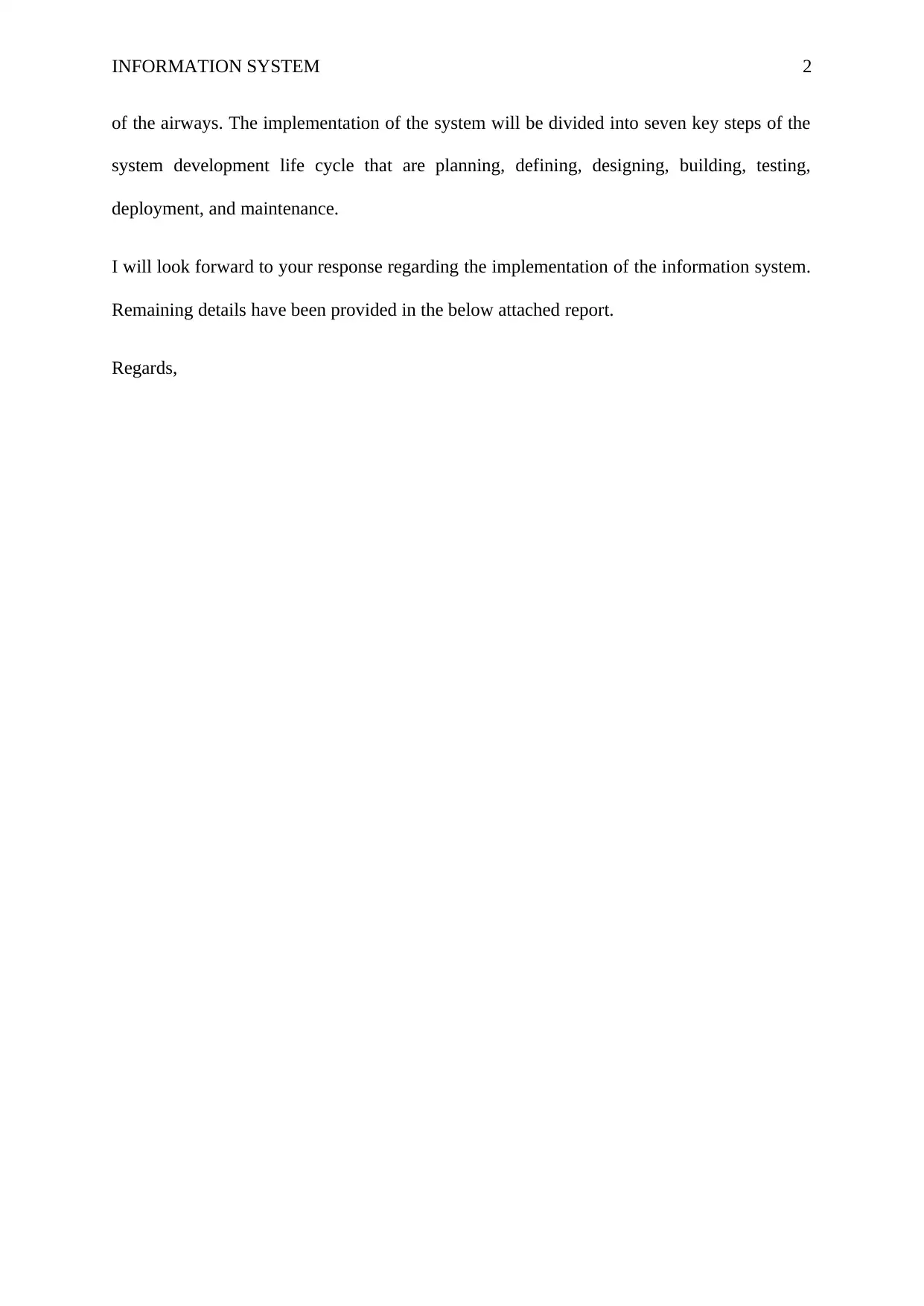
INFORMATION SYSTEM 2
of the airways. The implementation of the system will be divided into seven key steps of the
system development life cycle that are planning, defining, designing, building, testing,
deployment, and maintenance.
I will look forward to your response regarding the implementation of the information system.
Remaining details have been provided in the below attached report.
Regards,
of the airways. The implementation of the system will be divided into seven key steps of the
system development life cycle that are planning, defining, designing, building, testing,
deployment, and maintenance.
I will look forward to your response regarding the implementation of the information system.
Remaining details have been provided in the below attached report.
Regards,
⊘ This is a preview!⊘
Do you want full access?
Subscribe today to unlock all pages.

Trusted by 1+ million students worldwide
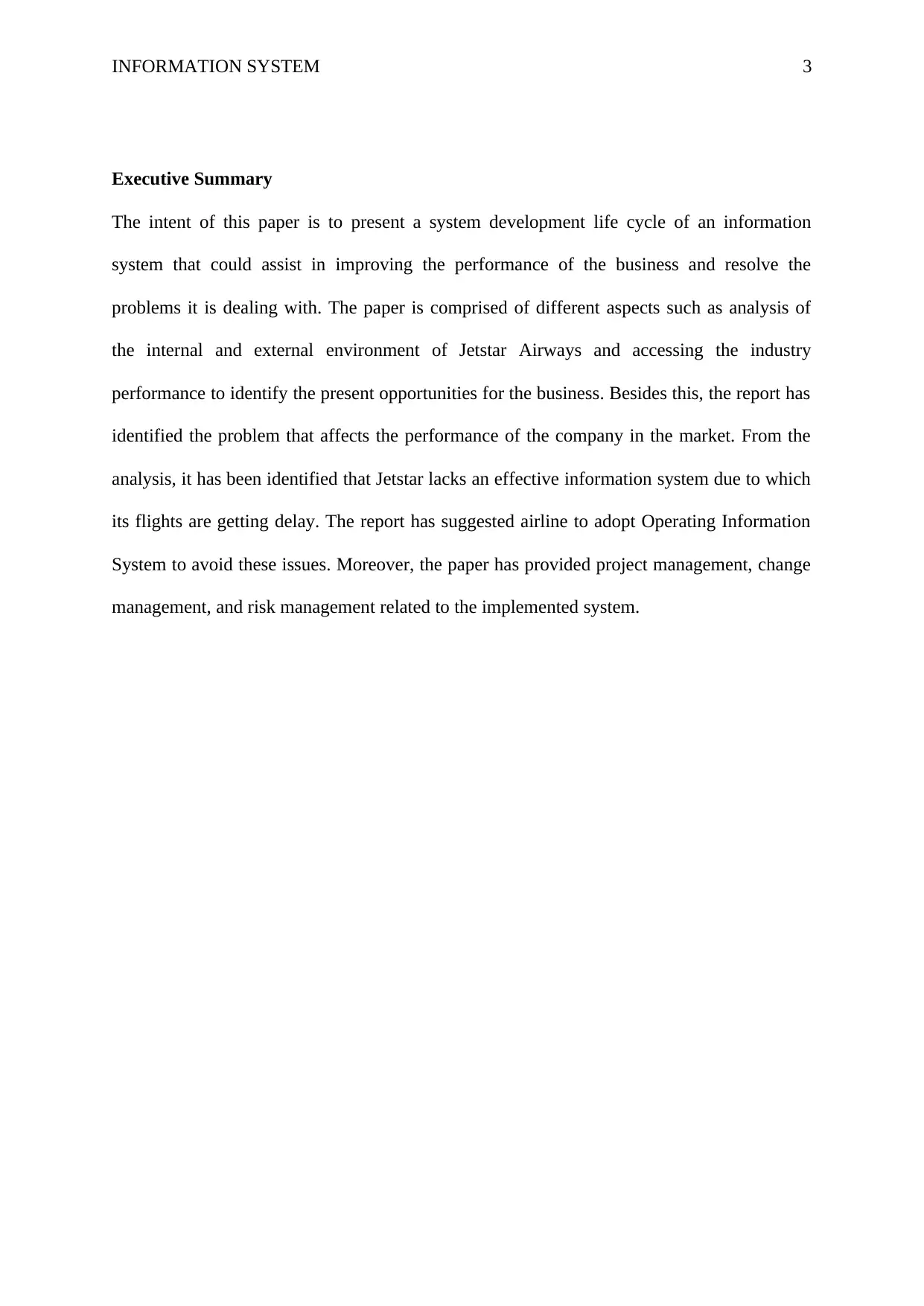
INFORMATION SYSTEM 3
Executive Summary
The intent of this paper is to present a system development life cycle of an information
system that could assist in improving the performance of the business and resolve the
problems it is dealing with. The paper is comprised of different aspects such as analysis of
the internal and external environment of Jetstar Airways and accessing the industry
performance to identify the present opportunities for the business. Besides this, the report has
identified the problem that affects the performance of the company in the market. From the
analysis, it has been identified that Jetstar lacks an effective information system due to which
its flights are getting delay. The report has suggested airline to adopt Operating Information
System to avoid these issues. Moreover, the paper has provided project management, change
management, and risk management related to the implemented system.
Executive Summary
The intent of this paper is to present a system development life cycle of an information
system that could assist in improving the performance of the business and resolve the
problems it is dealing with. The paper is comprised of different aspects such as analysis of
the internal and external environment of Jetstar Airways and accessing the industry
performance to identify the present opportunities for the business. Besides this, the report has
identified the problem that affects the performance of the company in the market. From the
analysis, it has been identified that Jetstar lacks an effective information system due to which
its flights are getting delay. The report has suggested airline to adopt Operating Information
System to avoid these issues. Moreover, the paper has provided project management, change
management, and risk management related to the implemented system.
Paraphrase This Document
Need a fresh take? Get an instant paraphrase of this document with our AI Paraphraser
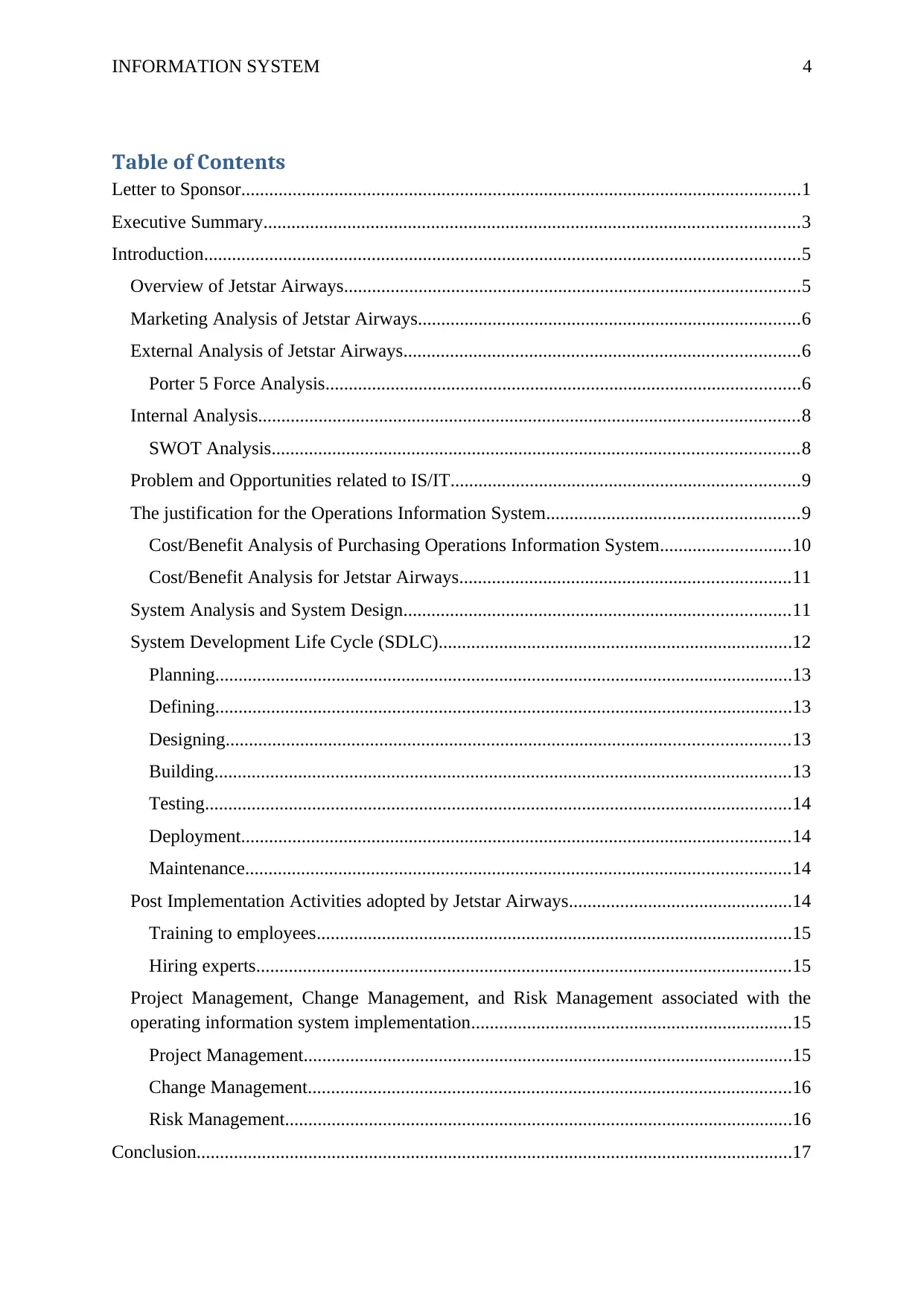
INFORMATION SYSTEM 4
Table of Contents
Letter to Sponsor........................................................................................................................1
Executive Summary...................................................................................................................3
Introduction................................................................................................................................5
Overview of Jetstar Airways..................................................................................................5
Marketing Analysis of Jetstar Airways..................................................................................6
External Analysis of Jetstar Airways.....................................................................................6
Porter 5 Force Analysis......................................................................................................6
Internal Analysis....................................................................................................................8
SWOT Analysis.................................................................................................................8
Problem and Opportunities related to IS/IT...........................................................................9
The justification for the Operations Information System......................................................9
Cost/Benefit Analysis of Purchasing Operations Information System............................10
Cost/Benefit Analysis for Jetstar Airways.......................................................................11
System Analysis and System Design...................................................................................11
System Development Life Cycle (SDLC)............................................................................12
Planning............................................................................................................................13
Defining............................................................................................................................13
Designing.........................................................................................................................13
Building............................................................................................................................13
Testing..............................................................................................................................14
Deployment......................................................................................................................14
Maintenance.....................................................................................................................14
Post Implementation Activities adopted by Jetstar Airways................................................14
Training to employees......................................................................................................15
Hiring experts...................................................................................................................15
Project Management, Change Management, and Risk Management associated with the
operating information system implementation.....................................................................15
Project Management.........................................................................................................15
Change Management........................................................................................................16
Risk Management.............................................................................................................16
Conclusion................................................................................................................................17
Table of Contents
Letter to Sponsor........................................................................................................................1
Executive Summary...................................................................................................................3
Introduction................................................................................................................................5
Overview of Jetstar Airways..................................................................................................5
Marketing Analysis of Jetstar Airways..................................................................................6
External Analysis of Jetstar Airways.....................................................................................6
Porter 5 Force Analysis......................................................................................................6
Internal Analysis....................................................................................................................8
SWOT Analysis.................................................................................................................8
Problem and Opportunities related to IS/IT...........................................................................9
The justification for the Operations Information System......................................................9
Cost/Benefit Analysis of Purchasing Operations Information System............................10
Cost/Benefit Analysis for Jetstar Airways.......................................................................11
System Analysis and System Design...................................................................................11
System Development Life Cycle (SDLC)............................................................................12
Planning............................................................................................................................13
Defining............................................................................................................................13
Designing.........................................................................................................................13
Building............................................................................................................................13
Testing..............................................................................................................................14
Deployment......................................................................................................................14
Maintenance.....................................................................................................................14
Post Implementation Activities adopted by Jetstar Airways................................................14
Training to employees......................................................................................................15
Hiring experts...................................................................................................................15
Project Management, Change Management, and Risk Management associated with the
operating information system implementation.....................................................................15
Project Management.........................................................................................................15
Change Management........................................................................................................16
Risk Management.............................................................................................................16
Conclusion................................................................................................................................17

INFORMATION SYSTEM 5
References................................................................................................................................19
References................................................................................................................................19
⊘ This is a preview!⊘
Do you want full access?
Subscribe today to unlock all pages.

Trusted by 1+ million students worldwide
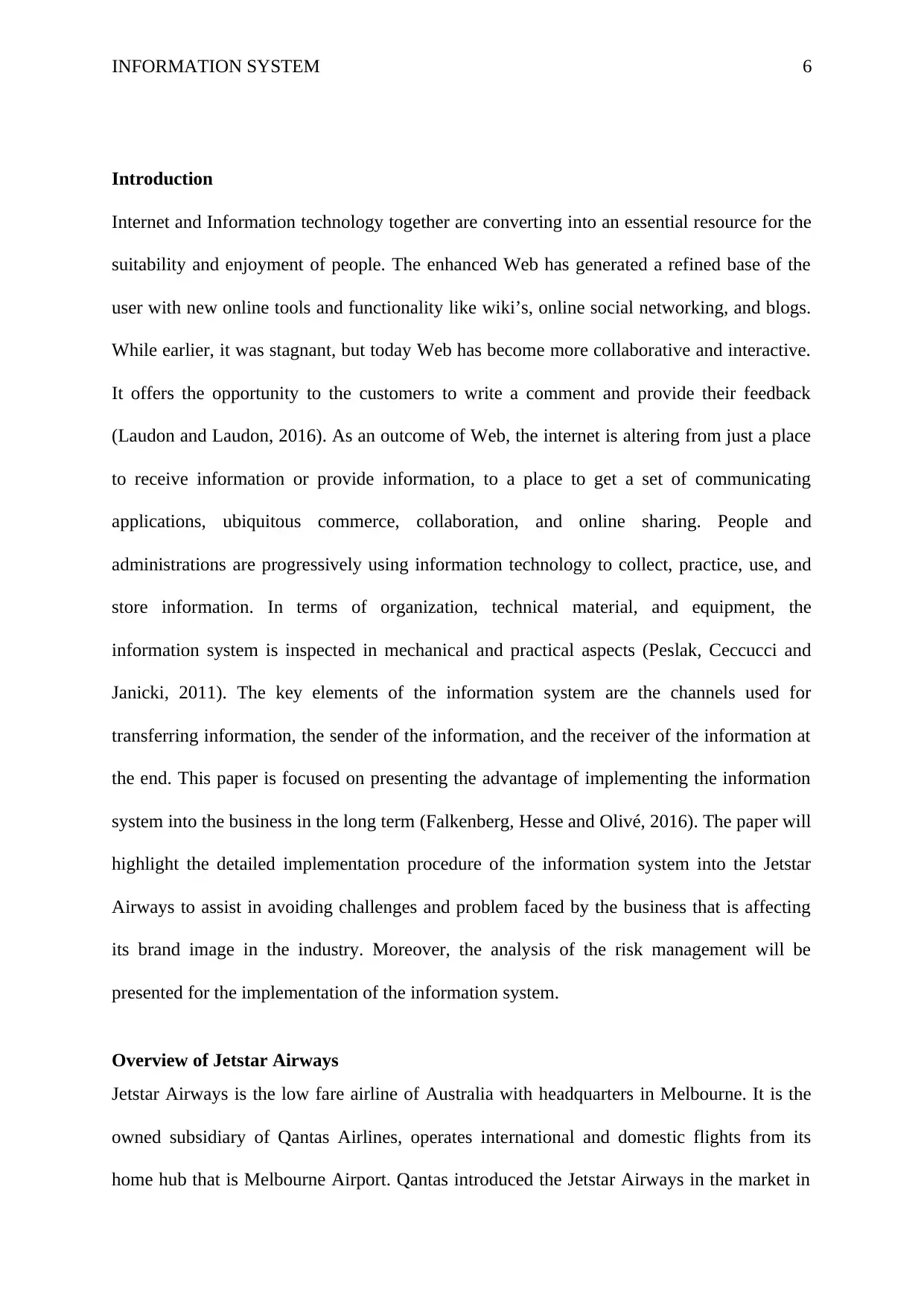
INFORMATION SYSTEM 6
Introduction
Internet and Information technology together are converting into an essential resource for the
suitability and enjoyment of people. The enhanced Web has generated a refined base of the
user with new online tools and functionality like wiki’s, online social networking, and blogs.
While earlier, it was stagnant, but today Web has become more collaborative and interactive.
It offers the opportunity to the customers to write a comment and provide their feedback
(Laudon and Laudon, 2016). As an outcome of Web, the internet is altering from just a place
to receive information or provide information, to a place to get a set of communicating
applications, ubiquitous commerce, collaboration, and online sharing. People and
administrations are progressively using information technology to collect, practice, use, and
store information. In terms of organization, technical material, and equipment, the
information system is inspected in mechanical and practical aspects (Peslak, Ceccucci and
Janicki, 2011). The key elements of the information system are the channels used for
transferring information, the sender of the information, and the receiver of the information at
the end. This paper is focused on presenting the advantage of implementing the information
system into the business in the long term (Falkenberg, Hesse and Olivé, 2016). The paper will
highlight the detailed implementation procedure of the information system into the Jetstar
Airways to assist in avoiding challenges and problem faced by the business that is affecting
its brand image in the industry. Moreover, the analysis of the risk management will be
presented for the implementation of the information system.
Overview of Jetstar Airways
Jetstar Airways is the low fare airline of Australia with headquarters in Melbourne. It is the
owned subsidiary of Qantas Airlines, operates international and domestic flights from its
home hub that is Melbourne Airport. Qantas introduced the Jetstar Airways in the market in
Introduction
Internet and Information technology together are converting into an essential resource for the
suitability and enjoyment of people. The enhanced Web has generated a refined base of the
user with new online tools and functionality like wiki’s, online social networking, and blogs.
While earlier, it was stagnant, but today Web has become more collaborative and interactive.
It offers the opportunity to the customers to write a comment and provide their feedback
(Laudon and Laudon, 2016). As an outcome of Web, the internet is altering from just a place
to receive information or provide information, to a place to get a set of communicating
applications, ubiquitous commerce, collaboration, and online sharing. People and
administrations are progressively using information technology to collect, practice, use, and
store information. In terms of organization, technical material, and equipment, the
information system is inspected in mechanical and practical aspects (Peslak, Ceccucci and
Janicki, 2011). The key elements of the information system are the channels used for
transferring information, the sender of the information, and the receiver of the information at
the end. This paper is focused on presenting the advantage of implementing the information
system into the business in the long term (Falkenberg, Hesse and Olivé, 2016). The paper will
highlight the detailed implementation procedure of the information system into the Jetstar
Airways to assist in avoiding challenges and problem faced by the business that is affecting
its brand image in the industry. Moreover, the analysis of the risk management will be
presented for the implementation of the information system.
Overview of Jetstar Airways
Jetstar Airways is the low fare airline of Australia with headquarters in Melbourne. It is the
owned subsidiary of Qantas Airlines, operates international and domestic flights from its
home hub that is Melbourne Airport. Qantas introduced the Jetstar Airways in the market in
Paraphrase This Document
Need a fresh take? Get an instant paraphrase of this document with our AI Paraphraser
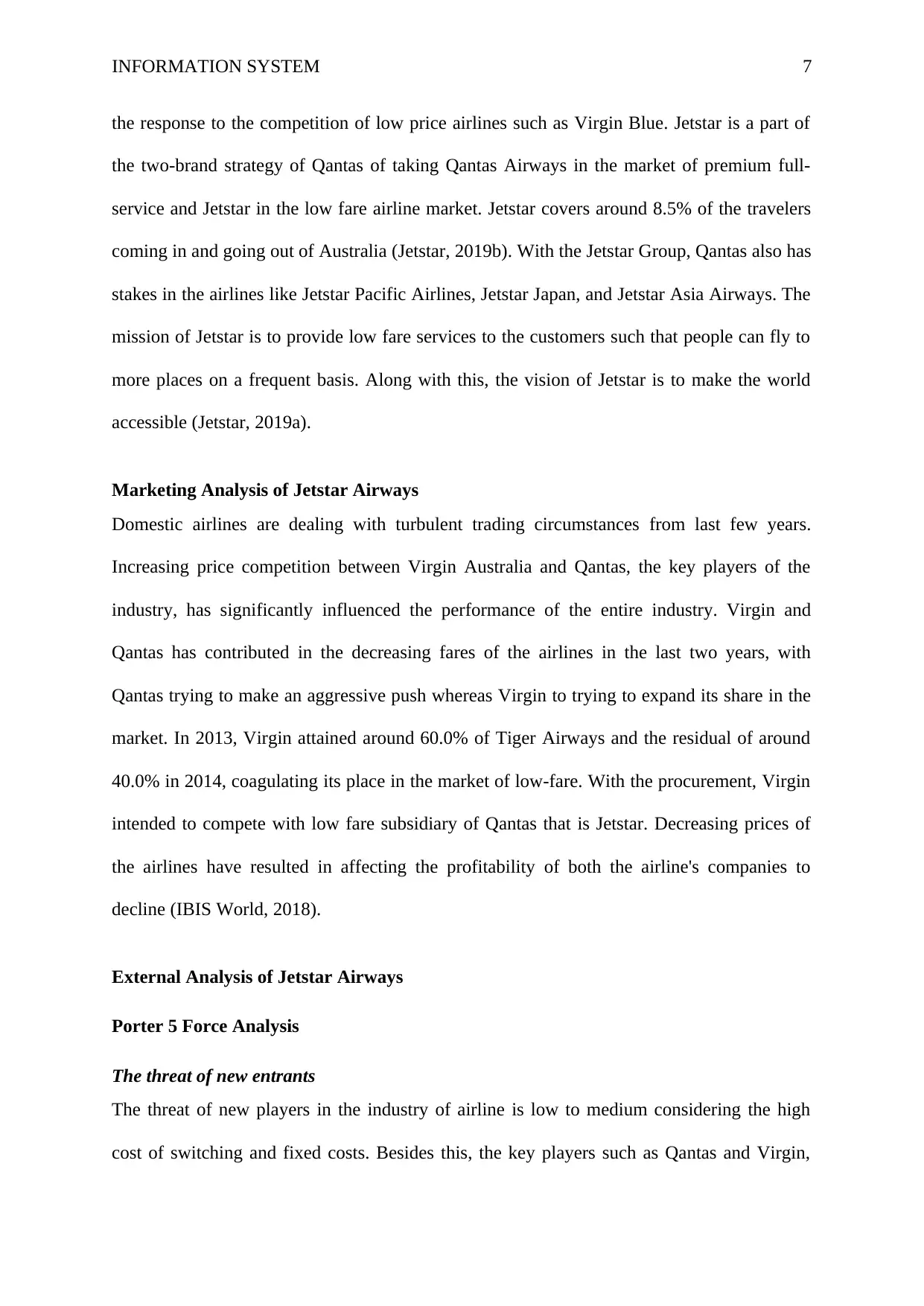
INFORMATION SYSTEM 7
the response to the competition of low price airlines such as Virgin Blue. Jetstar is a part of
the two-brand strategy of Qantas of taking Qantas Airways in the market of premium full-
service and Jetstar in the low fare airline market. Jetstar covers around 8.5% of the travelers
coming in and going out of Australia (Jetstar, 2019b). With the Jetstar Group, Qantas also has
stakes in the airlines like Jetstar Pacific Airlines, Jetstar Japan, and Jetstar Asia Airways. The
mission of Jetstar is to provide low fare services to the customers such that people can fly to
more places on a frequent basis. Along with this, the vision of Jetstar is to make the world
accessible (Jetstar, 2019a).
Marketing Analysis of Jetstar Airways
Domestic airlines are dealing with turbulent trading circumstances from last few years.
Increasing price competition between Virgin Australia and Qantas, the key players of the
industry, has significantly influenced the performance of the entire industry. Virgin and
Qantas has contributed in the decreasing fares of the airlines in the last two years, with
Qantas trying to make an aggressive push whereas Virgin to trying to expand its share in the
market. In 2013, Virgin attained around 60.0% of Tiger Airways and the residual of around
40.0% in 2014, coagulating its place in the market of low-fare. With the procurement, Virgin
intended to compete with low fare subsidiary of Qantas that is Jetstar. Decreasing prices of
the airlines have resulted in affecting the profitability of both the airline's companies to
decline (IBIS World, 2018).
External Analysis of Jetstar Airways
Porter 5 Force Analysis
The threat of new entrants
The threat of new players in the industry of airline is low to medium considering the high
cost of switching and fixed costs. Besides this, the key players such as Qantas and Virgin,
the response to the competition of low price airlines such as Virgin Blue. Jetstar is a part of
the two-brand strategy of Qantas of taking Qantas Airways in the market of premium full-
service and Jetstar in the low fare airline market. Jetstar covers around 8.5% of the travelers
coming in and going out of Australia (Jetstar, 2019b). With the Jetstar Group, Qantas also has
stakes in the airlines like Jetstar Pacific Airlines, Jetstar Japan, and Jetstar Asia Airways. The
mission of Jetstar is to provide low fare services to the customers such that people can fly to
more places on a frequent basis. Along with this, the vision of Jetstar is to make the world
accessible (Jetstar, 2019a).
Marketing Analysis of Jetstar Airways
Domestic airlines are dealing with turbulent trading circumstances from last few years.
Increasing price competition between Virgin Australia and Qantas, the key players of the
industry, has significantly influenced the performance of the entire industry. Virgin and
Qantas has contributed in the decreasing fares of the airlines in the last two years, with
Qantas trying to make an aggressive push whereas Virgin to trying to expand its share in the
market. In 2013, Virgin attained around 60.0% of Tiger Airways and the residual of around
40.0% in 2014, coagulating its place in the market of low-fare. With the procurement, Virgin
intended to compete with low fare subsidiary of Qantas that is Jetstar. Decreasing prices of
the airlines have resulted in affecting the profitability of both the airline's companies to
decline (IBIS World, 2018).
External Analysis of Jetstar Airways
Porter 5 Force Analysis
The threat of new entrants
The threat of new players in the industry of airline is low to medium considering the high
cost of switching and fixed costs. Besides this, the key players such as Qantas and Virgin,
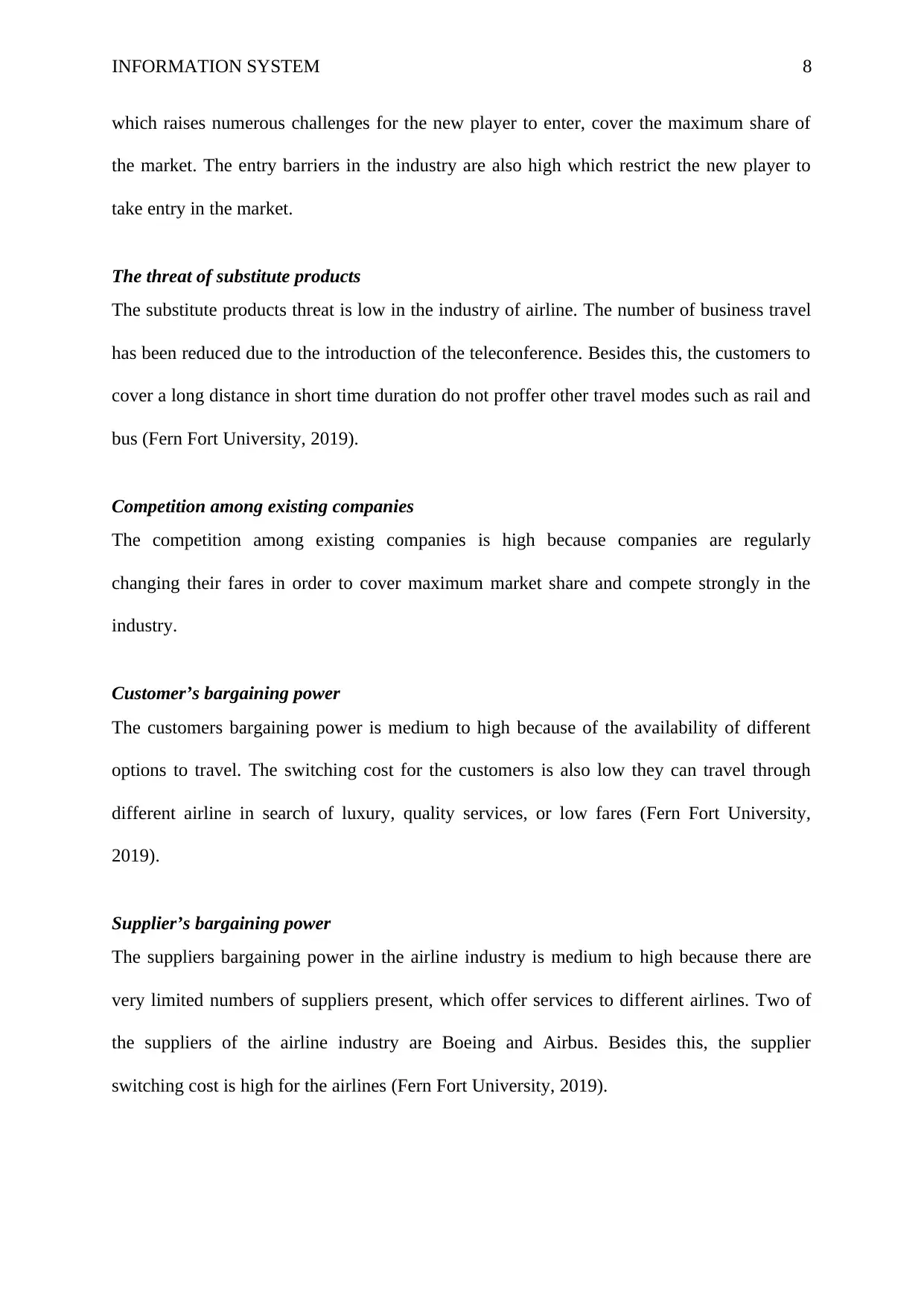
INFORMATION SYSTEM 8
which raises numerous challenges for the new player to enter, cover the maximum share of
the market. The entry barriers in the industry are also high which restrict the new player to
take entry in the market.
The threat of substitute products
The substitute products threat is low in the industry of airline. The number of business travel
has been reduced due to the introduction of the teleconference. Besides this, the customers to
cover a long distance in short time duration do not proffer other travel modes such as rail and
bus (Fern Fort University, 2019).
Competition among existing companies
The competition among existing companies is high because companies are regularly
changing their fares in order to cover maximum market share and compete strongly in the
industry.
Customer’s bargaining power
The customers bargaining power is medium to high because of the availability of different
options to travel. The switching cost for the customers is also low they can travel through
different airline in search of luxury, quality services, or low fares (Fern Fort University,
2019).
Supplier’s bargaining power
The suppliers bargaining power in the airline industry is medium to high because there are
very limited numbers of suppliers present, which offer services to different airlines. Two of
the suppliers of the airline industry are Boeing and Airbus. Besides this, the supplier
switching cost is high for the airlines (Fern Fort University, 2019).
which raises numerous challenges for the new player to enter, cover the maximum share of
the market. The entry barriers in the industry are also high which restrict the new player to
take entry in the market.
The threat of substitute products
The substitute products threat is low in the industry of airline. The number of business travel
has been reduced due to the introduction of the teleconference. Besides this, the customers to
cover a long distance in short time duration do not proffer other travel modes such as rail and
bus (Fern Fort University, 2019).
Competition among existing companies
The competition among existing companies is high because companies are regularly
changing their fares in order to cover maximum market share and compete strongly in the
industry.
Customer’s bargaining power
The customers bargaining power is medium to high because of the availability of different
options to travel. The switching cost for the customers is also low they can travel through
different airline in search of luxury, quality services, or low fares (Fern Fort University,
2019).
Supplier’s bargaining power
The suppliers bargaining power in the airline industry is medium to high because there are
very limited numbers of suppliers present, which offer services to different airlines. Two of
the suppliers of the airline industry are Boeing and Airbus. Besides this, the supplier
switching cost is high for the airlines (Fern Fort University, 2019).
⊘ This is a preview!⊘
Do you want full access?
Subscribe today to unlock all pages.

Trusted by 1+ million students worldwide
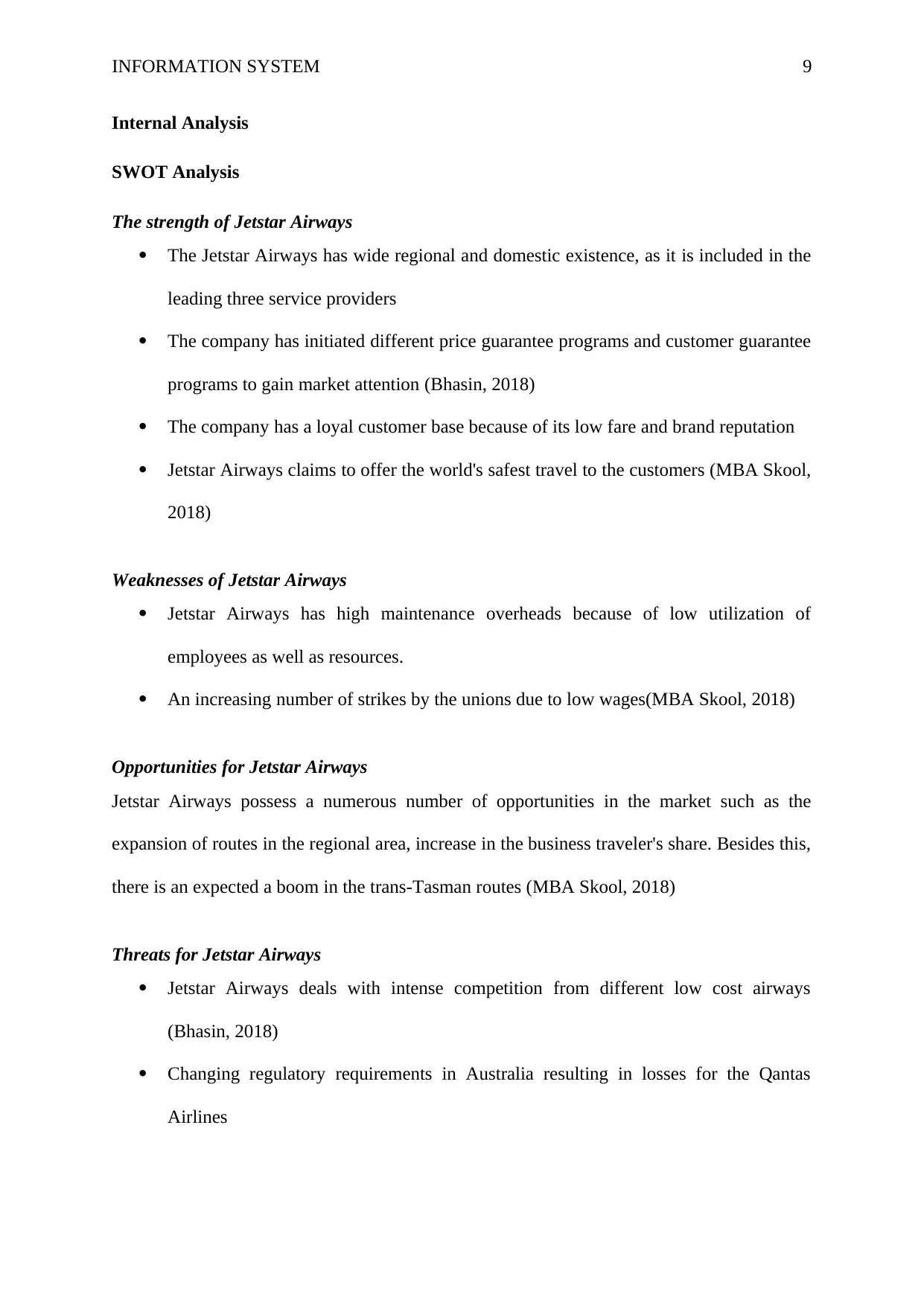
INFORMATION SYSTEM 9
Internal Analysis
SWOT Analysis
The strength of Jetstar Airways
The Jetstar Airways has wide regional and domestic existence, as it is included in the
leading three service providers
The company has initiated different price guarantee programs and customer guarantee
programs to gain market attention (Bhasin, 2018)
The company has a loyal customer base because of its low fare and brand reputation
Jetstar Airways claims to offer the world's safest travel to the customers (MBA Skool,
2018)
Weaknesses of Jetstar Airways
Jetstar Airways has high maintenance overheads because of low utilization of
employees as well as resources.
An increasing number of strikes by the unions due to low wages(MBA Skool, 2018)
Opportunities for Jetstar Airways
Jetstar Airways possess a numerous number of opportunities in the market such as the
expansion of routes in the regional area, increase in the business traveler's share. Besides this,
there is an expected a boom in the trans-Tasman routes (MBA Skool, 2018)
Threats for Jetstar Airways
Jetstar Airways deals with intense competition from different low cost airways
(Bhasin, 2018)
Changing regulatory requirements in Australia resulting in losses for the Qantas
Airlines
Internal Analysis
SWOT Analysis
The strength of Jetstar Airways
The Jetstar Airways has wide regional and domestic existence, as it is included in the
leading three service providers
The company has initiated different price guarantee programs and customer guarantee
programs to gain market attention (Bhasin, 2018)
The company has a loyal customer base because of its low fare and brand reputation
Jetstar Airways claims to offer the world's safest travel to the customers (MBA Skool,
2018)
Weaknesses of Jetstar Airways
Jetstar Airways has high maintenance overheads because of low utilization of
employees as well as resources.
An increasing number of strikes by the unions due to low wages(MBA Skool, 2018)
Opportunities for Jetstar Airways
Jetstar Airways possess a numerous number of opportunities in the market such as the
expansion of routes in the regional area, increase in the business traveler's share. Besides this,
there is an expected a boom in the trans-Tasman routes (MBA Skool, 2018)
Threats for Jetstar Airways
Jetstar Airways deals with intense competition from different low cost airways
(Bhasin, 2018)
Changing regulatory requirements in Australia resulting in losses for the Qantas
Airlines
Paraphrase This Document
Need a fresh take? Get an instant paraphrase of this document with our AI Paraphraser
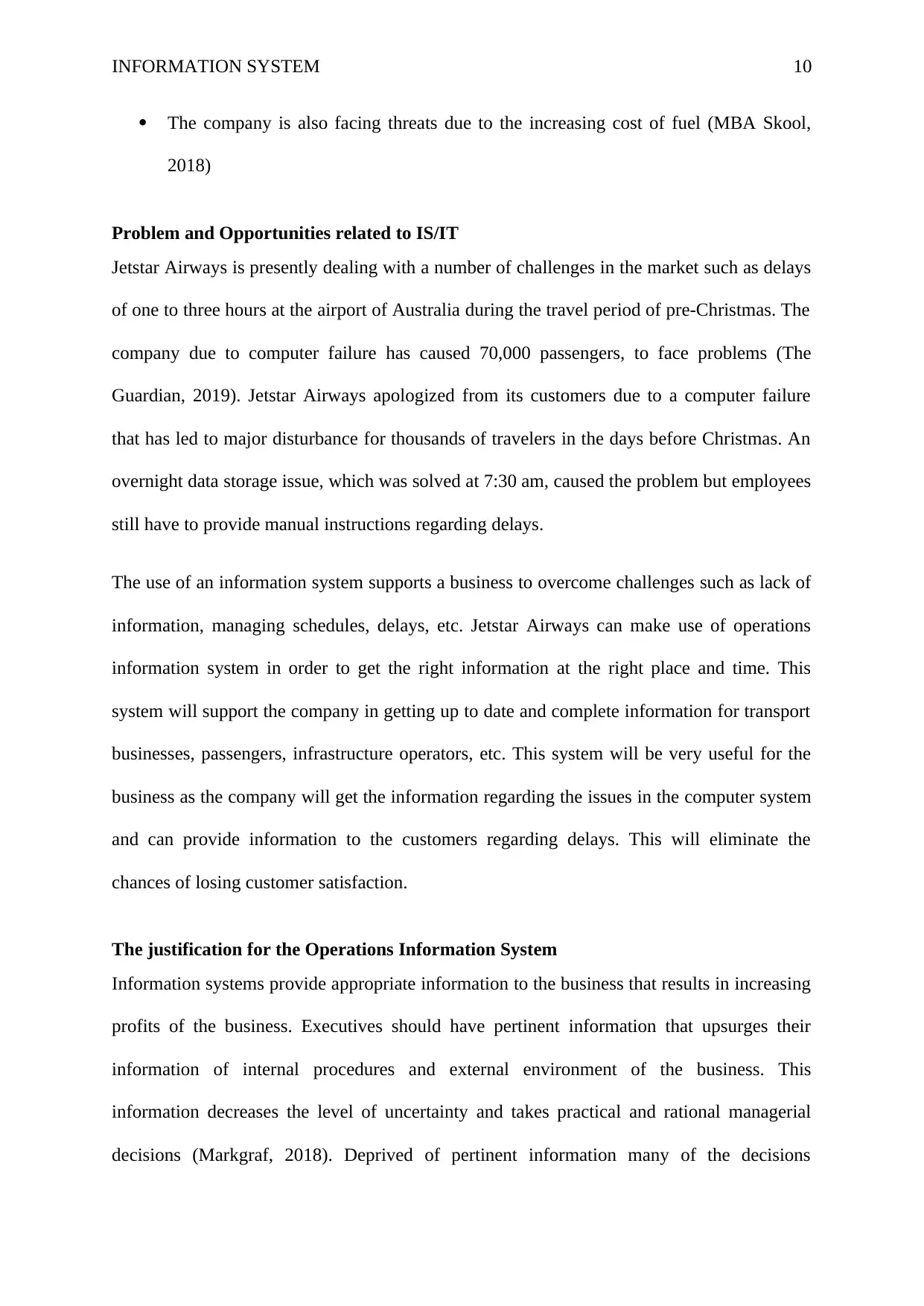
INFORMATION SYSTEM 10
The company is also facing threats due to the increasing cost of fuel (MBA Skool,
2018)
Problem and Opportunities related to IS/IT
Jetstar Airways is presently dealing with a number of challenges in the market such as delays
of one to three hours at the airport of Australia during the travel period of pre-Christmas. The
company due to computer failure has caused 70,000 passengers, to face problems (The
Guardian, 2019). Jetstar Airways apologized from its customers due to a computer failure
that has led to major disturbance for thousands of travelers in the days before Christmas. An
overnight data storage issue, which was solved at 7:30 am, caused the problem but employees
still have to provide manual instructions regarding delays.
The use of an information system supports a business to overcome challenges such as lack of
information, managing schedules, delays, etc. Jetstar Airways can make use of operations
information system in order to get the right information at the right place and time. This
system will support the company in getting up to date and complete information for transport
businesses, passengers, infrastructure operators, etc. This system will be very useful for the
business as the company will get the information regarding the issues in the computer system
and can provide information to the customers regarding delays. This will eliminate the
chances of losing customer satisfaction.
The justification for the Operations Information System
Information systems provide appropriate information to the business that results in increasing
profits of the business. Executives should have pertinent information that upsurges their
information of internal procedures and external environment of the business. This
information decreases the level of uncertainty and takes practical and rational managerial
decisions (Markgraf, 2018). Deprived of pertinent information many of the decisions
The company is also facing threats due to the increasing cost of fuel (MBA Skool,
2018)
Problem and Opportunities related to IS/IT
Jetstar Airways is presently dealing with a number of challenges in the market such as delays
of one to three hours at the airport of Australia during the travel period of pre-Christmas. The
company due to computer failure has caused 70,000 passengers, to face problems (The
Guardian, 2019). Jetstar Airways apologized from its customers due to a computer failure
that has led to major disturbance for thousands of travelers in the days before Christmas. An
overnight data storage issue, which was solved at 7:30 am, caused the problem but employees
still have to provide manual instructions regarding delays.
The use of an information system supports a business to overcome challenges such as lack of
information, managing schedules, delays, etc. Jetstar Airways can make use of operations
information system in order to get the right information at the right place and time. This
system will support the company in getting up to date and complete information for transport
businesses, passengers, infrastructure operators, etc. This system will be very useful for the
business as the company will get the information regarding the issues in the computer system
and can provide information to the customers regarding delays. This will eliminate the
chances of losing customer satisfaction.
The justification for the Operations Information System
Information systems provide appropriate information to the business that results in increasing
profits of the business. Executives should have pertinent information that upsurges their
information of internal procedures and external environment of the business. This
information decreases the level of uncertainty and takes practical and rational managerial
decisions (Markgraf, 2018). Deprived of pertinent information many of the decisions
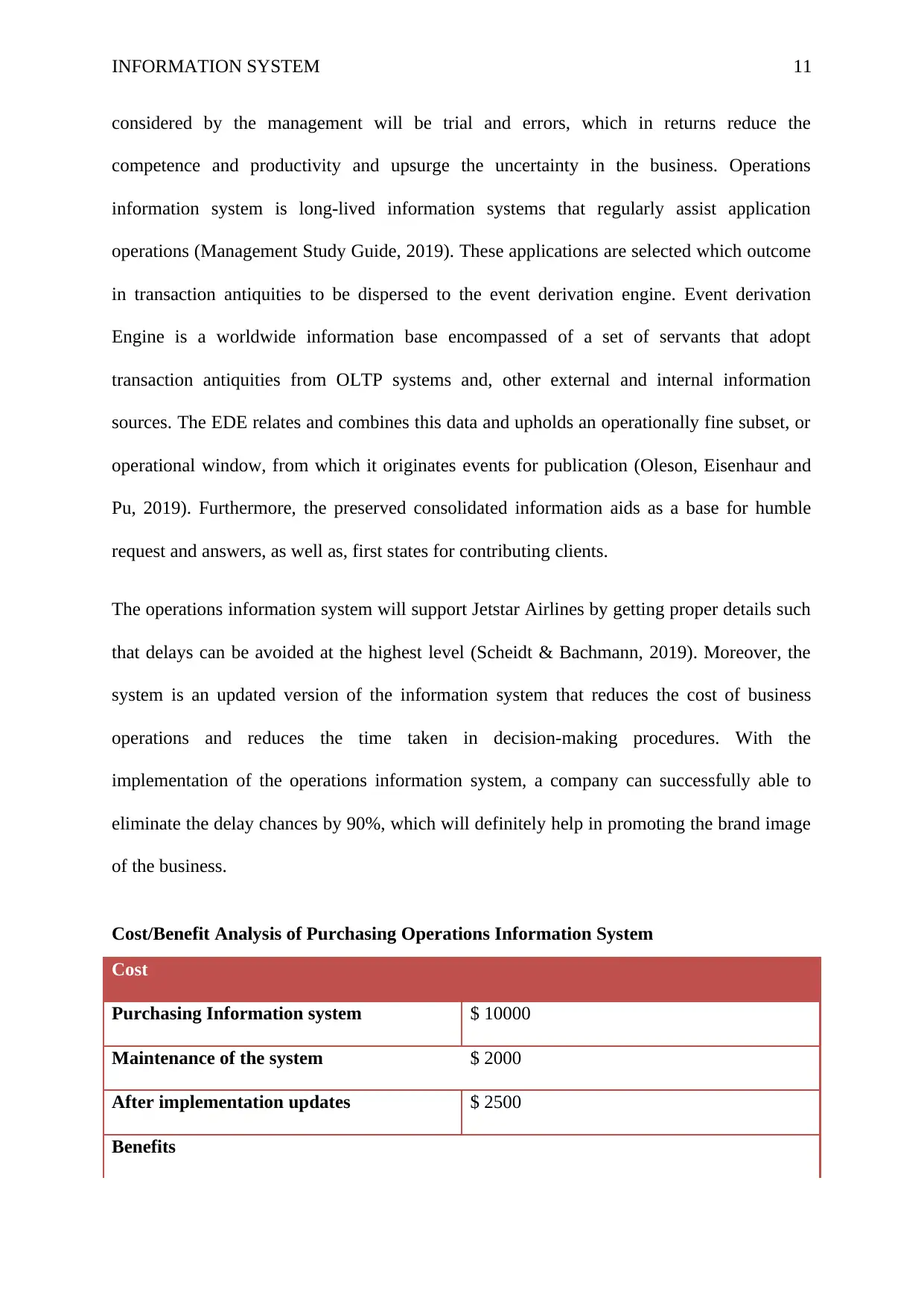
INFORMATION SYSTEM 11
considered by the management will be trial and errors, which in returns reduce the
competence and productivity and upsurge the uncertainty in the business. Operations
information system is long-lived information systems that regularly assist application
operations (Management Study Guide, 2019). These applications are selected which outcome
in transaction antiquities to be dispersed to the event derivation engine. Event derivation
Engine is a worldwide information base encompassed of a set of servants that adopt
transaction antiquities from OLTP systems and, other external and internal information
sources. The EDE relates and combines this data and upholds an operationally fine subset, or
operational window, from which it originates events for publication (Oleson, Eisenhaur and
Pu, 2019). Furthermore, the preserved consolidated information aids as a base for humble
request and answers, as well as, first states for contributing clients.
The operations information system will support Jetstar Airlines by getting proper details such
that delays can be avoided at the highest level (Scheidt & Bachmann, 2019). Moreover, the
system is an updated version of the information system that reduces the cost of business
operations and reduces the time taken in decision-making procedures. With the
implementation of the operations information system, a company can successfully able to
eliminate the delay chances by 90%, which will definitely help in promoting the brand image
of the business.
Cost/Benefit Analysis of Purchasing Operations Information System
Cost
Purchasing Information system $ 10000
Maintenance of the system $ 2000
After implementation updates $ 2500
Benefits
considered by the management will be trial and errors, which in returns reduce the
competence and productivity and upsurge the uncertainty in the business. Operations
information system is long-lived information systems that regularly assist application
operations (Management Study Guide, 2019). These applications are selected which outcome
in transaction antiquities to be dispersed to the event derivation engine. Event derivation
Engine is a worldwide information base encompassed of a set of servants that adopt
transaction antiquities from OLTP systems and, other external and internal information
sources. The EDE relates and combines this data and upholds an operationally fine subset, or
operational window, from which it originates events for publication (Oleson, Eisenhaur and
Pu, 2019). Furthermore, the preserved consolidated information aids as a base for humble
request and answers, as well as, first states for contributing clients.
The operations information system will support Jetstar Airlines by getting proper details such
that delays can be avoided at the highest level (Scheidt & Bachmann, 2019). Moreover, the
system is an updated version of the information system that reduces the cost of business
operations and reduces the time taken in decision-making procedures. With the
implementation of the operations information system, a company can successfully able to
eliminate the delay chances by 90%, which will definitely help in promoting the brand image
of the business.
Cost/Benefit Analysis of Purchasing Operations Information System
Cost
Purchasing Information system $ 10000
Maintenance of the system $ 2000
After implementation updates $ 2500
Benefits
⊘ This is a preview!⊘
Do you want full access?
Subscribe today to unlock all pages.

Trusted by 1+ million students worldwide
1 out of 23
Related Documents
Your All-in-One AI-Powered Toolkit for Academic Success.
+13062052269
info@desklib.com
Available 24*7 on WhatsApp / Email
![[object Object]](/_next/static/media/star-bottom.7253800d.svg)
Unlock your academic potential
Copyright © 2020–2025 A2Z Services. All Rights Reserved. Developed and managed by ZUCOL.




